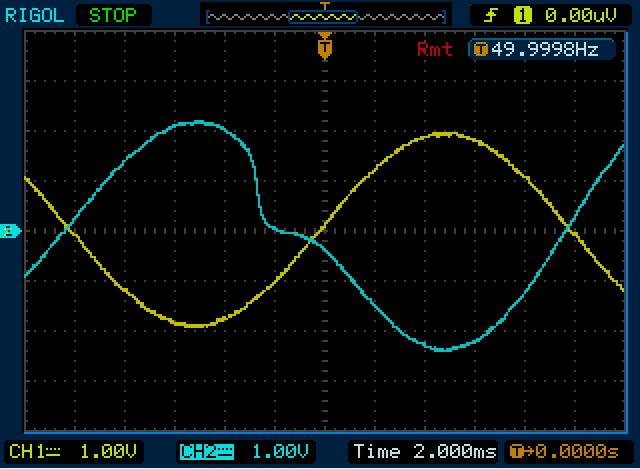warpie
Well-known member
- Joined
- Feb 7, 2009
- Messages
- 1,605
Kingston said:RME HDSP AD/DA input and output set to 0 dBFS (+13 dBu).
Kingston said:RME HDSP AD/DA input and output set to 0 dBFS (+13 dBu).
Kingston said:
(yellow waveform with cap, blue with no cap)
emrr said:That would add another potentially helpful balancing mechanism, but might yield worse results than the current plan. Maybe no different, maybe better.
May be of interest to also try simply moving 4.7 from one side to CT-ground position, with DC current potential across primary still present, but with an AC to ground path. I don't expect much out of that one, but might be surprised.
Script said:Electronics is a hobby to me and I'm hardly more than an amateur, especially when it comes to tube gear, so please forgive me asking: In your schematic, what's the function of the 1N4007 diode, 1M resistor and 10nf in the SC? And why a 1N4007? Wouldn't a low forward voltage drop diode be better here?
The 4uf7 OT cap: Now this is what I call an improvement. Is this image software or an oscilloscope?
lolo-m said:And don't be stupid, if the specs you posted are real, just remove the schemo, go and talk to Eva Manley and sell it. Their varimu has got a "tube mastering grade noise floor" of -85 dB. Yours claim -106 or so...
fenchelteefee said:lolo-m said:And don't be stupid, if the specs you posted are real, just remove the schemo, go and talk to Eva Manley and sell it. Their varimu has got a "tube mastering grade noise floor" of -85 dB. Yours claim -106 or so...
To see somebody encouraging to sell a design contribution to an audio manufator in a DIY forum is something new and kind a outrageous.
Why not recommending the Linux guys in an open source forum to sell the stuff to Mr. Gates?
lolo-m said:fenchelteefee said:lolo-m said:And don't be stupid, if the specs you posted are real, just remove the schemo, go and talk to Eva Manley and sell it. Their varimu has got a "tube mastering grade noise floor" of -85 dB. Yours claim -106 or so...
To see somebody encouraging to sell a design contribution to an audio manufator in a DIY forum is something new and kind a outrageous.
Why not recommending the Linux guys in an open source forum to sell the stuff to Mr. Gates?
You certainly don't know me !
Kingston said:-106dBFS. With the AD/DA I'm using that results to -93dBu. Still pretty good.
lolo-m said:-100dB s/n is quite normal for solid state technology
- 85dB is really good for tube technology
Being under -90dB qualify you as an exceptional higrade tube technology.
Even if I don't think Manley stuff is exceptional, the brand is known to do great stuff with great performances. A lot of recognised mastering studios use their tube stuff. They anounce a maximun s/n of -85dB... Reading -106dB on the specs of Kingston comp was quite surprising !
Script said:HPF: the 2K resistor in the high pass filter section yields the desired effect? Corner frequency is 36.2Hz? Probably I'm missing something here (inductance of the TX?). How about using a pot here with 20R in series?
It's a balanced high pass filter. Post number three: http://www.gearslutz.com/board/geekslutz-forum/356482-easy-diy-passive-filter.html
and additional info with even simulation data http://www.groupdiy.com/index.php?topic=38211.0
creal said:very nice geoff004.
Can you post picture and info about the cut trace and your little PC board.
I like to try this mods too